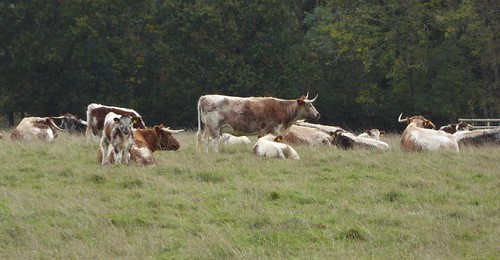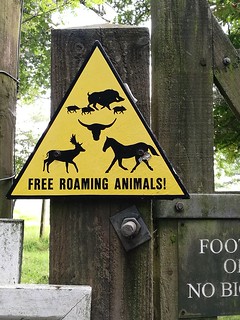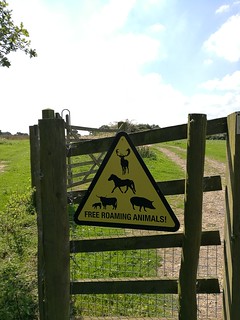Christs Hospital to Billingshurst via Knepp Castle Walk
Long flat walk with an emphasis on fauna in a re-wilding area, and passing several historic buildings.
Photos
Add your photos to the SWC Group on Flickr, and tag them:


Wild Exmoor ponies, Knepp Wildlands
Oct-18 • Saturdaywalker on Flickr
swcwalks swcwalk283 walkicon 45143418234


Longhorn cattle, Knepp Wildlands
walkicon
Oct-18 • Saturdaywalker on Flickr
swcwalks swcwalk283 45818325442




'Free roaming animals'.
You are about to enter the happy (e)state.
knepp rewilding freeroaming sustainability sustainablefarming 36334474333


![The Importance of Rootling Tamworth pig and piglets make their way to the pond for some more snuffling. Their presence is having positive effect: 'Rootling exposes bare soil, allowing pioneer plants like sallow (hybridised willow) to colonise. Sallow is the food source of the purple emperor butterfly. Before rewilding there were no purple emperors on Knepp. Now [it has] the largest breeding population in the UK. [The soil] is also colonised by solitary bees, and the over-turned clods of earth kick-start the creation of anthills which, in turn, provide food for Knepp's burgeoning population of green woodpeckers. Rootling also provides opportunities for so-called 'weed' species - like chickweed, scarlet pimpernel, vetchlings, common fumitory, knotgrass and red fescue - food source of the critically endangered turtle dove. Before...the rewilding [project there were] no turtle doves at Knepp. By 2017 [it had] at least 14 purring males, and...they are breeding because...fledglings [have been seen]. Turtle doves are, according to the RSPB, the most likely bird to go extinct within [the UK's] shores by 2020. Knepp is the only place in the country where turtle dove numbers are increasing. Could the turtle doves' success here be a consequence, at least in part, of [Kneep's] rootling pigs? - Knepp Rewilding.](https://live.staticflickr.com/4353/37006036761_8be5ca8d1b.jpg)
The Importance of Rootling
Tamworth pig and piglets make their way to the pond for some more snuffling. Their presence is having positive effect: 'Rootling exposes bare soil, allowing pioneer plants like sallow (hybridised willow) to colonise. Sallow is the food source of the purple emperor butterfly. Before rewilding there were no purple emperors on Knepp. Now [it has] the largest breeding population in the UK. [The soil] is also colonised by solitary bees, and the over-turned clods of earth kick-start the creation of anthills which, in turn, provide food for Knepp's burgeoning population of green woodpeckers. Rootling also provides opportunities for so-called 'weed' species - like chickweed, scarlet pimpernel, vetchlings, common fumitory, knotgrass and red fescue - food source of the critically endangered turtle dove. Before...the rewilding [project there were] no turtle doves at Knepp. By 2017 [it had] at least 14 purring males, and...they are breeding because...fledglings [have been seen]. Turtle doves are, according to the RSPB, the most likely bird to go extinct within [the UK's] shores by 2020. Knepp is the only place in the country where turtle dove numbers are increasing. Could the turtle doves' success here be a consequence, at least in part, of [Kneep's] rootling pigs? - Knepp Rewilding.
rootling tamworthpigs rewilding butterflies turtledove knepp bees sustainability endangeredspecies 37006036761



Old English Longhorns
Knepp Old English Loghorn Cattle - help enrich nature and the land with their more sustainable grazing methods and hardy nature: 'Longhorns have particular methods and preferences of grazing. With no upper set of front teeth, they wrap their long tongues around grass and flowers. Using their horns to pull down branches, they rip off twigs and eat the leaves. This has a kind of pollarding or coppicing effect on trees and shrubs. They particularly favour...emerging sallow (hybridised willow) scrub, whose astringent leaves (containing salicylic acid, the active metabolite of aspirin) act as a natural anti-inflammatory and may also relieve worm burden. After giving birth, cows often tuck into patches of nettles, rich in iron. Cattle are also important vectors of seeds, transporting up to 230 species of plants around a landscape through their gut, hooves and fur...an extraordinary number.' - Knepp Rewilding.
rewilding longhorn knepp 36312025714



